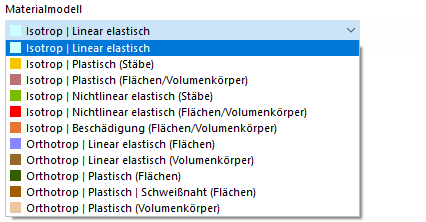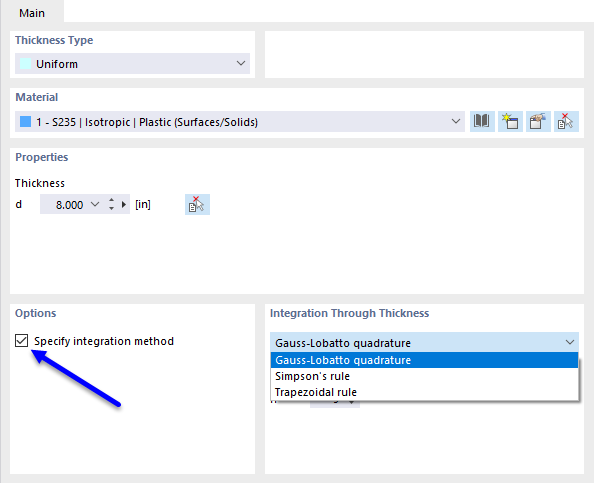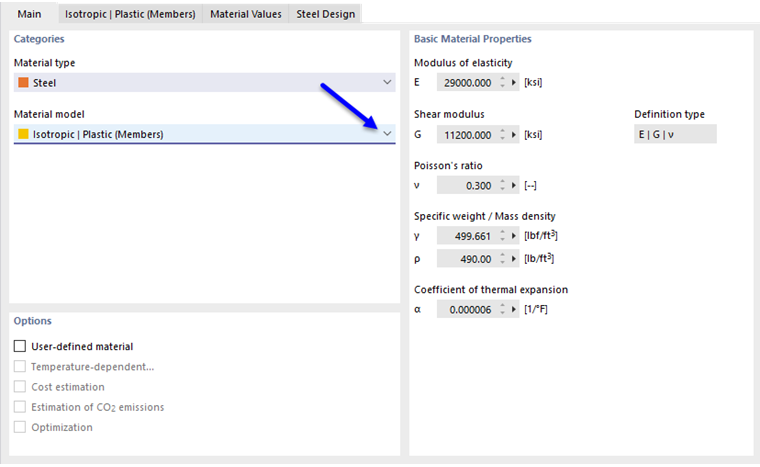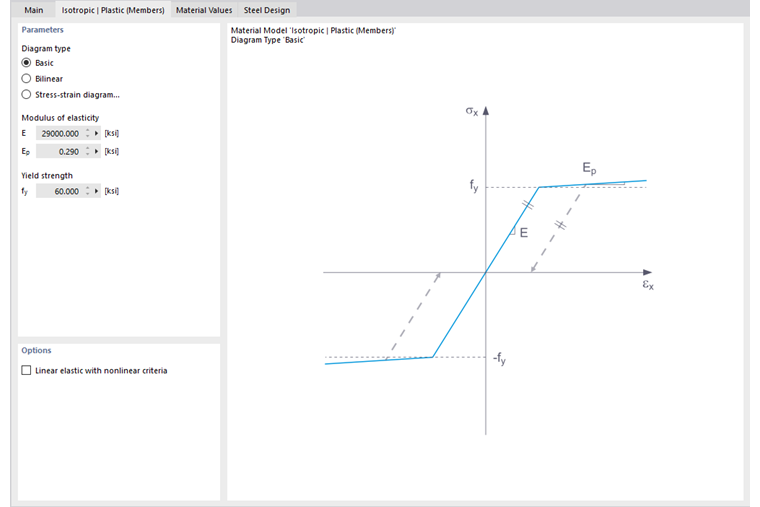如果在模型 - 基本数据中激活了非线性材料行为分析模块(需要许可),那么除了'各向同性 | 线弹性'和'正交各向异性 | 还会出现材料的弹塑性和非线性弹性模型供用户选择。
当模型中使用弹塑性材料时,程序会进行迭代计算。 不同的材料弹塑性模型提供了不同的应力应变关系(本构关系)。
材料的弹塑性模型中,刚度并不是一个定值。在进行计算时,程序需要不断修正结构的刚度矩阵,反复迭代以得到满足用户定义的应力-应变关系的数值解。 在迭代计算应力过程中,如果模型中存在面和实体单元, 因此,我们建议在评估应力时始终使用恒定的网格单元平滑类型。
RFEM 中的非线性材料模型分为【塑性】和【非线性弹性】。
非线性弹性材料的卸载后,应力应变曲线将沿原路径返回原点, 不存在残余的塑性变形。
塑性材料在卸载后,存在不可恢复的塑性应变。塑性材料卸载时应力应变曲线将沿下图的灰色路径。
关于非线性材料模型的背景信息可以在描述各向同性非线性弹性模型的技术文章中找到。材料模型.]]
非线性材料板的内力和弯矩,是通过在板厚度 d 上的应力数值积分得出的。 要定义厚度的积分方法,请在'编辑厚度'对话框中选择指定积分方法选项。 有以下几种集成方法:
- 高斯-洛巴托积分(Gauss-Lobatto quadrature)
- 辛普森法(Simpson's rule)
- 梯形法
此外,您还可以通过板厚度将'积分点的数目'指定为 3 到 99。
各向同性塑性(杆件)
当选择各向同性 | 打开【各向同性 - 塑性(杆件)】选项卡输入材料参数。
在【各向同性-塑性(杆件)】选项卡下, 可以选择将应力-应变曲线定义为以下类型:
- 普通版
- 双线性
- 应力-应变图
如果选择基本,则 RFEM 使用双线性材料模型。 弹性模量 E 和屈服强度 fy的数值来自材料数据库。
如果要更改屈服强度和弹性模量的值,请激活'基本'选项卡中的“用户自定义材料”复选框。
对于双线性定义的截面,用户可以直接输入 Ep的数值。
使用“应力-应变图”可以定义更复杂的应力-应变关系。 选择该选项后,会出现【应力-应变图】选项卡,用户可以在该选项卡下以表格的形式定义应力-应变曲线。
该表格中的每一行对应着应力-应变曲线上的一个点。 应力-应变曲线在输入的最后一个点之后的曲线走向可以在右侧图标下方的【图表开始-受拉】下拉菜单中选择。
选择【撕裂】,最后一点之后的应力会变成零。 【屈服】表示最后一点之后的应力保持恒定。 【连续】表示最后一点之后的应力-应变曲线以该点处的斜率继续延伸。
各向同性塑性(面/实体)
当勾选“各向同性 | '材料模型'下拉列表中的“材料模型:塑性(面/实体)”选项卡,
Wählen Sie zunächst die 'Spannungsversagenshypothese' Zur Auswahl stehen diese
在【应力破坏假设】下, 用户可以选择不同的屈服准则:
- von Mises(米塞斯屈服准则)
- Tresca(屈雷斯加屈服准则)
- Drucker-Prager
- Mohr-Coulomb
当选择“von Mises”时,应力-应变曲线中的应力如下:
面积:
实体:
根据 "Tresca" 应力,使用以下应力:
面积:
实体:
根据 "Drucker-Prager" 应力假设,下列的应力被用于面和实体:
根据 "Mohr-Coulomb" 应力应变表达式,
各向同性非线性弹性(杆件)
该功能与各向同性塑性(杆件)材料模型基本相对应。 不同之处在于【各向同性|非线性弹性(面/实体)】材料模型的应力应变曲线不存在卸载的塑性应变。
各向同性非线性弹性(面/实体)
该功能与各向同性塑性(面/实体)材料模型基本相对应。 不同之处在于【各向同性|非线性弹性(面/实体)】材料模型的应力应变曲线不存在卸载的塑性应变。
各向同性损伤(面/实体)
与其他材料模型不同,【各向同性|损伤(面/实体)】材料模型的应力应变曲线不关于原点中心对称。 该材料模型可以用于模拟受拉强度与受压强度不同的材料,例如钢筋混凝土。 关于钢纤维混凝土建模的详细信息参见技术文章确定钢纤维混凝土的材料属性钢筋混凝土。
使用损伤因子这一标量参数来考虑材料的失效特性。 一般情况下,存在于材料内部的损伤(微裂缝、空腔)是有方向性的。 当损伤变量与材料受力面的法向相关时,为各向异性损伤; 当损伤变量与法向无关时,为各向同性损伤,这时的损伤变量为一标量。 规范附录中给出的混凝土应力-应变曲线是根据应变等效性推导的损伤演化方程得出的。
【参照单元尺寸】影响了非线性分析中的单元尺寸效应。 程序默认【参照单元尺寸】为 0, 以便真实模拟钢筋混凝土的材料性能。
有关'各向同性损伤'材料模型理论背景的更多信息,请参阅描述该材料模型的技术文章,[https://www.dlubal.com/zh/support-and-learning/support/knowledge-base/001461 非线性材料模型损伤。
正交各向异性塑性(面)和正交各向异性塑性(实体)
程序根据 Tsai-Wu 失效准则给出了【正交各向异性|塑性(面)】和【正交各向异性|塑性(实体)】的材料模型。 该材料模型适用于编织材料、木材等具有各向异性的材料。
当材料进入塑性后,应力不再随应变增长, 保持恒定。
BILD
BILD
弹性区对应于正交各向异性材料模型。 下面的 Tsai-Wu 屈服条件适用于塑性区:
对于 2D 平面应力状态:
FORMEL
对于空间应力状态:
FORMEL
所有强度都必须有正值。
用户可以将应力准则看成应力空间中的椭圆面, 投影在各个平面上为一个椭圆。
如果根据 Tsai-Wu 方程(平面应力条件)的 fy (σ) 小于 1,则应力位于弹性区。 一旦 fy (σ) = 1,则进入塑性区。不允许有大于 1 的值。即塑性阶段应力不随着应变继续变化。












